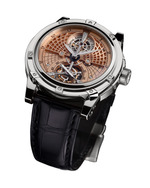"ASTROLABE" TOURBILLON
Louis Moinet unveils its latest creation, inspired by one of mankind's oldest but least-known astronomical instruments, the astrolabe.
An astrolabe is an instrument used to observe the stars and was of great importance in the development of the human sciences. The word astrolabe comes from the Greek astrolabos, which means "an instrument to measure the height of the stars".
The instrument is represented in the form of a double flat projection which measures the movement of the stars in the heavens. Its invention is attributed to the Greek scientist Hipparchus (c. 190 to c. 120 BC). Its use became widespread from the 8th century under the rule of Arabic astronomers.
Its purpose is to observe the stars as well as determine the time (in the daytime by observing the sun, at night by observing the stars). A simpler version, the nautical astrolabe was the main navigational instrument from the 16th century up until the 18th century.
Measuring the height of the stars
The astrolabe is made up of a disk graduated in degrees and a rotating arm attached to its centre, called an alidade. The alidade pivots on its axis and is directed towards the sun or a star to read on the disk's markers the angle representing the height of the sun or a major known star in relation to the horizon. The astrolabe is held vertically in the hand by a ring; the stars are sighted by turning the viewfinder until one of them is seen by both ends. The value in degrees obtained by the viewfinder on the arc may be converted into degrees of latitude from the observation point. Time is also determined by the height of the star.
An object of fascination
The astrolabe is a mythical object, which links man to the great mysteries of the universe. The Arabs among others excelled in creating them to the highest artistic quality. Even though the use of a 19th century astrolabe is no longer possible today, due to the planets' shifting with time, it remains one of the most fascinating objects of human genius.
Where can you see a genuine astrolabe?
The astrolabe is an exceptional object and only a few museums preserve them in their collections. Jean-Marie Schaller, CEO of Louis Moinet, sought to obtain one. This is how an encounter came about with Martin Brunold, probably the only manufacturer of quality astrolabes in the world. For more than forty years this Swiss craftsman has made them entirely by hand, patiently crafted from brass. He has of course an extremely limited production capacity and his works of art are displayed in international museums or belong to private collections.
Technical specifications
Features and functions
Exclusive tourbillon escapement
Central hour and minutes
Seconds
Movement
Exclusive tourbillon escapement
Winding Manual
Mechanism visible through the case-back with "octopus" spring
Oscillations 21,600 vph
Frequency 3 Hz
Lines 14 ½
Power reserve 72 hours
Tourbillon cage One full rotation every 60 seconds
Jewels 19
Escapement Side lever
Decoration "Côtes du Jura" ® engraving, blued steel screws
Case
Original design by Louis Moinet®, made up of 59 parts
Material 18k white gold
Case diameter 47 mm
Water-resistance 30 metres
Caseback Secured with 6 screws, engraved with individual number and Louis Moinet markings
Crystals Two anti-reflective sapphire crystals
Dial
Design is inspired by one of the world's oldest astronomical instrument: the astrolabe
Strap
Strap Louisiana alligator leather, hand-sewn, width between lugs : 24 mm
Buckle 18k white gold with Louis Moinet symbol
Presentation box Extra large Louis Moinet Book, containing one authentic handcrafted astrolabe realized by the artist Mr. Brunold
Rarity Limited Edition of 12 pieces
Reference no. LM-14.70.30
| 







